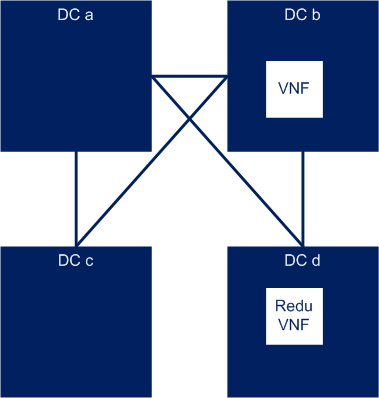2.4. Georedundancy¶
Georedundancy refers to a configuration which ensures the service continuity of the VNF-s even if a whole datacenter fails.
It is possible that the VNF application layer provides additional redundancy with VNF pooling on top of the georedundancy functionality described here.
It is possible that either the VNFC-s of a single VNF are spread across several datacenters (this case is covered by the OPNFV multisite project [MULTISITE] or different, redundant VNF-s are started in different datacenters.
When the different VNF-s are started in different datacenters the redundancy can be achieved by redundant VNF-s in a hot (spare VNF is running its configuration and internal state is synchronised to the active VNF), warm (spare VNF is running, its configuration is synchronised to the active VNF) or cold (spare VNF is not running, active VNF-s configuration is stored in a persistent, central store and configured to the spare VNF during its activation) standby state in a different datacenter from where the active VNF-s are running. The synchronisation and data transfer can be handled by the application or by the infrastructure.
In all of these georedundancy setups there is a need for a network connection between the datacenter running the active VNF and the datacenter running the spare VNF.
In case of a distributed cloud it is possible that the georedundant cloud of an application is not predefined or changed and the change requires configuration in the underlay networks when the network operator uses network isolation. Isolation of the traffic between the datacenters might be needed due to the multitenant usage of NFVI/VIM or due to the IP pool management of the network operator.
This set of georedundancy use cases is about enabling the possiblity to select a datacenter as backup datacenter and build the connectivity between the NFVI-s in the different datacenters in a programmable way.
The focus of these uses cases is on the functionality of OpenStack it is not considered how the provisioning of physical resources is handled by the SDN controllers to interconnect the two datacenters.
As an example the following picture (Fig. 2.4) shows a multicell cloud setup where the underlay network is not fully mashed.
Each datacenter (DC) is a separate OpenStack cell, region or instance. Let’s assume that a new VNF is started in DC b with a Redundant VNF in DC d. In this case a direct underlay network connection is needed between DC b and DC d. The configuration of this connection should be programable in both DC b and DC d. The result of the deployment is shown in the following figure (Fig. 2.5):
2.4.3. Conclusion¶
An API is needed what provides possibility to set up the local and remote endpoints for the underlay network. This API present in the SDN solutions, but OpenStack does not provides and abstracted API for this functionality to hide the differences of the SDN solutions.


